Travelin’ Man goes to St. Louis – Part II

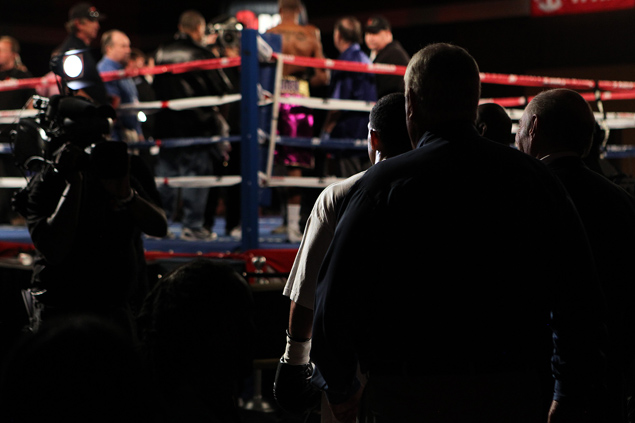
Friday, Oct. 12: For me, this day began at 8 a.m. sharp following six hours of unusually sound slumber (the Ameristar Casino’s mattresses were very comfortable). I spent most of the first four hours trying to articulate everything that had transpired the previous day as well as surfing the web to catch up on the latest news – boxing and otherwise.
Although my call time wasn’t until 2 p.m. my restless, compulsively punctual soul couldn’t stay still that long. The completion of my writing duties combined with my not being a gamblin’ man greatly limited my entertainment options in a casino setting. Therefore, I went down to the lobby to print my boarding pass, then, at 12:30 I dropped by the arena to check things out. I visited briefly with photographer Tom Casino and production manager Joie Silva then wandered the property for an hour before returning to the conference center. For whatever reason, I derive great comfort from being where I need to be well before I need to be there.
All went well electronically and as punch-counting partner Andy Kasprzak and I scanned the bout sheet we thought two things; first, most of the fighters in the red corner were going to win (they did, going 6-2-1) and second, most of the nine fights would end quickly and explosively (of the scheduled 60 rounds, only 35 were fought, an average slightly under four rounds per bout).
The night began with New York heavyweight Tor Hamer hammering Topeka’s Dominic Alexander in a little more than four minutes, raising his record to 19-1 (12) while lowering Alexander’s to 23-15-1 (11), including 13 losses inside the distance. Hamer was the aggressor throughout, smartly softening up the taller Alexander with jabs to the body then pouncing the moment he suspected his opponent was hurt. All three knockdowns (two in round one, one in round two) were the result of Hamer’s tornado-like volleys that swirled in from all legal directions, volleys that caused Alexander to collapse more from volume as much as the impact of Hamer’s blows. A succession of crisp combinations following the second-round knockdown prompted referee Celestino Ruiz to intervene.
The typical heavyweight averages 46 punches per round, but in round one Hamer was 47 of 96 overall (49 percent) and 34 of 68 in power shots (50 percent). In the 62 seconds that round two lasted, Hamer unleashed 59 punches, including 46 hooks, crosses or uppercuts. That kind of volume is incredible for any weight class, but the fact that a heavyweight did it was unusual to say the least.
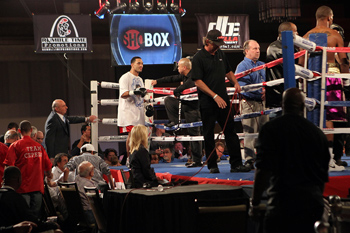 The next fight produced the first surprise of the night, as blue corner occupant Zac Kelley of Earlsboro, Oklahoma blasted out local product Chris Rapa in 113 seconds to raise his ledger to 1-1 (1) while also removing Rapa from the undefeated ranks (6-1, 0). Both appeared to have the same game plan – wreck the other man as quickly as possible – and one early exchange set the tone. Rapa emerged from it with a small mouse under his left eye and a facial expression that indicated this task would be much tougher than he anticipated. Rapa’s troubles worsened moments later when an accidental butt opened a gash over the right eye that bled copiously. Rapa’s legs looked unsteady and his resolve looked to be somewhat shaken. A series of chopping blows drove Rapa to a knee, persuading Mike England to call a halt.
The next fight produced the first surprise of the night, as blue corner occupant Zac Kelley of Earlsboro, Oklahoma blasted out local product Chris Rapa in 113 seconds to raise his ledger to 1-1 (1) while also removing Rapa from the undefeated ranks (6-1, 0). Both appeared to have the same game plan – wreck the other man as quickly as possible – and one early exchange set the tone. Rapa emerged from it with a small mouse under his left eye and a facial expression that indicated this task would be much tougher than he anticipated. Rapa’s troubles worsened moments later when an accidental butt opened a gash over the right eye that bled copiously. Rapa’s legs looked unsteady and his resolve looked to be somewhat shaken. A series of chopping blows drove Rapa to a knee, persuading Mike England to call a halt.
Several more surprises were in store during lightweight Dannie Williams’ scheduled eight round tune-up against southpaw journeyman Rynell Griffin. As mentioned in Part One, Griffin wasn’t expected to offer much competition (he had gone 0-8-1 in his last nine) but everything changed 1 minute 40 seconds into round two when a counter left to the chest combined with Williams’ bad balance produced a flash knockdown near Williams’ corner. It happened again in round four when a right to the chin decked Williams in the fourth and the favorite’s problems mounted in the fifth when Griffin opened a slice over Williams’ right eye.
At the halfway point it appeared a massive upset was possible, especially if the two knockdown rounds had been scored 10-8. Although Williams grunted with every attempted power shot they didn’t appear to affect Griffin much because his face was composed and his concentration was steely.
More often than not, however, class rises to the top and that process came to a head in round six. No longer grunting, Williams now was hitting with genuine power and his scything body blows gradually wore Griffin down to the nub. Williams scored three knockdowns in the sixth with hard punches to the flanks and with no three-knockdown rule in effect the fight was allowed to go into a seventh round.
Griffin’s once inscrutable face now betrayed his duress, his eyes and mouth flinching every time he sensed another blockbuster headed toward his body. The damage already done, Williams finished the fight 63 seconds into the seventh with a right to the temple that caused Griffin to turn away and take a knee, after which referee Ruiz stopped the fight.
Though the road to victory was filled with potholes, Williams achieved pronounced statistical advantages. He out-landed Griffin in every round, including the rounds he was knocked down (24-9 in round two, 31-12 in round four), meaning the judges could have scored those rounds 10-9 instead of the customary 10-8. Williams was 143 of 467 (31 percent) overall to Griffin’s 47 of 170 (28 percent) and of Williams 128 power connects, 68 struck the body. Williams landed an impressive 47 percent of his power punches (to Griffin’s 33 percent) and in the last three rounds he led 55-14 in power connects.
Cruiserweights Nick Reeder of St. Louis and Keith Jackson of Springfield entered the ring unbeaten (3-0, 2 KOs for the former, 1-0-1, 1 KO for the latter) and after their highly entertaining and punishing four rounder they left it the same way. That’s because all three judges saw it 38-38, but from this vantage point Reeder merited a 39-37 win. Jackson won the first round after hurting Reeder in the final minute but the local product appeared to sweep the final three by pronounced margins, both aesthetically and statistically.
The CompuBox stats showed Reeder with a 138-103 total connect edge and a 118-75 bulge in landed power shots. Reeder landed 44 percent of his total punches to Jackson’s 33 percent, he threw slightly more blows (314-300), landed more power punches (118-75) and was more accurate with his strongest blows (55 percent to 40 percent). In the final three rounds Reeder out-landed Jackson 112-65 (total) and 100-46 (power). It’s ironic that the hometown fighter was on the short end of a decision against an out-of-towner, but if the balance is to be fully made up this will have to happen a few thousand more times.
Jose Ponce, a stoutly built novice heavyweight from High Ridge, Mo., consistently landed southpaw lefts against debuting Quintell “The Superior” Thompson en route to a fourth round knockdown and a commanding 39-35 decision on all cards. For the most part it was a low-energy bout in terms of pace as the 36-year-old Ponce (now 4-0, 3) averaged 42.8 punches per round to Thompson’s 38.5 and out-landed him by small but consistent margins (44-29 total and 35-20 power). Ponce’s power punching accuracy was decisive as he landed 46 percent to Thompson’s 20 percent and out-landed him 18-3 in that department in the critical final round.
In a scheduled six-round light heavyweight fight, Kevin Engel raised his record to 20-6 (16) by out-pointing 37-year-old Shannon Miller (25-49-8 18) by near shutout scores of 60-54 (twice) and 59-55. Engel’s powerful upper body appeared two weight classes stronger than Miller’s and he used that brute strength to dictate the tone. After taking the first two rounds to warm up, Engel throttled up from round three forward while Miller fought at a steady, if slower, pace. Engel averaged 60 punches per round to Miller’s 38.5 and more than doubled his opponent’s total connects (119-55) while nearly tripling his power connects (101-36).
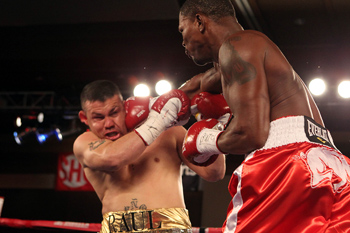 As mentioned in Part One, Showtime chose to air only highlights of former undisputed middleweight champion Jermain Taylor’s fight with journeyman Raul “Michi” Munoz, perhaps because Munoz was perceived as an inferior test. The suspicions were proved correct as Taylor crushed his shorter, stockier opponent with minimal stress.
As mentioned in Part One, Showtime chose to air only highlights of former undisputed middleweight champion Jermain Taylor’s fight with journeyman Raul “Michi” Munoz, perhaps because Munoz was perceived as an inferior test. The suspicions were proved correct as Taylor crushed his shorter, stockier opponent with minimal stress.
The 5-9 Munoz tried to get inside the 6-1 Taylor’s 74-inch reach but Taylor’s still-fast jabs kept him in the ex-champ’s preferred range. A right to the back of the ear caused Munoz to pitch forward to the canvas and a shotgun jab dropped him a second time moments later. Taylor polished off his earnest but overmatched rival in round two with a picturesque one-two to the jaw that caused Munoz to fall backwards in near slow motion. It was the perfect end to a nearly perfect performance.
The CompuBox stats reflected Taylor’s dominance. He was 30 of 80 overall in round one to Munoz’s 6 of 36 and was 16 of 33 in round two to Munoz’s 1 of 18. Taylor landed 41 percent of his total punches and 54 percent of his power shots while Munoz managed only 13 percent and 18 percent respectively.
Taylor proved he still has the tools to blast out fighters who can’t remotely measure up to his talent but will he be able to translate those skills enough to challenge the likes of Daniel Geale, Gennady Golovkin, Dmitry Pirog and especially Sergio Martinez? Will Team Taylor go after the winner of the October 27 interim title bout between Peter Quillin and Hassan N’Dam or will he wait for other options to emerge?
Taylor said his goal was to win a belt sometime in 2013 but in order for the 34-year-old to succeed he’ll first have to pick his targets carefully, then shoot as straight as he can. The question is whether his aim is still true. There was a time when Taylor could call his shot no matter what the target but those days are long gone. Here’s hoping, for his sake, that he will choose the correct course.
The first televised co-feature between middleweights Jonathan Cepeda and Lamar Russ was supposed to be a match of contrasting styles but in the end it was a game of role reversal. It also was a tale of two minutes, for Cepeda looked in charge for the first minute while a beautifully timed counter hook by Russ ended up changing everything. The blow stiffened Cepeda’s legs, knocked him off balance, widened his eyes and caused his upper body to pitch forward ever so slightly. Russ immediately seized on the signs of distress and went after him, driving him to the floor with a chopping right. Cepeda arose, but because his unsteady gait betrayed his true state referee England waved off the bout. The win lifted Russ to 11-0 (7) while Cepeda fell to 12-1 (11).
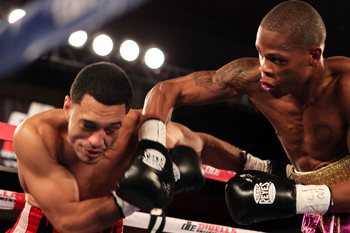 Russ was 16 of 46 overall (35 percent) to Cepeda’s 12 of 37 (32 percent). Russ led in jabs (7 of 24, 29 percent to 2 of 11, 18 percent) while Cepeda narrowly led in power punches (10 of 26, 38 percent to 9 of 22, 41 percent).
Russ was 16 of 46 overall (35 percent) to Cepeda’s 12 of 37 (32 percent). Russ led in jabs (7 of 24, 29 percent to 2 of 11, 18 percent) while Cepeda narrowly led in power punches (10 of 26, 38 percent to 9 of 22, 41 percent).
The stoppage seemed proper and for Russ it was a signature win that could propel him to more lucrative dates. The fight also highlighted the difference in strength of schedule; Russ’ last five opponents had a combined record of 43-19-2 (.672) while Cepeda’s foes were 41-33-4 (.526). For Cepeda, this is a tough reality check and ultimately it’s up to him whether it will be the start of a new beginning or the beginning of the end.
The main event between lightweight hopeful Jose Pedraza and last-minute sub Tevin Farmer was made more intriguing by the research I conducted earlier in the week when I was told Farmer was on the card. Though he lost an eight-round decision to the undefeated Kamil Laszczyk on a pay-per-view undercard in March, his southpaw stance, tricky movement, unusual punching angles, air of confidence and Philadelphia attitude told me this could be an interesting night.
“Either Pedraza’s people are extremely confident or they’re in for a rude awakening,” I said to myself as I counted punches off the video. “Philadelphia fighters with 7-4-1 records are as good, if not better, than 12-0 prospects from other parts of the country, and then throw in that style and his left-handedness. It’s not going to be easy for the Puerto Rican.”
It wasn’t, for Farmer took the fight to Pedraza early on and made it difficult for him to draw a bead. Pedraza, usually a volume puncher, threw just 21 in the first round to Farmer’s 84 and was out-landed 16-7. But Pedraza found his rhythm starting in round two when he went 29 of 77 overall and 27 of 72 in power shots and solidified it in the third by going 45 of 112 overall and 41 of 96 in power shots. Farmer did his best to hang in but the bigger, stronger and more talented Pedraza proved too much to handle. As was the case in round six of the Laszczyk fight, Farmer lost a point in round seven for excessive holding.
A telling sequence unfolded shortly before the finish. With 23 seconds gone in the eighth Farmer shot a left to the body, then recoiled in pain and fell to all fours. When Farmer was asked if he wanted to go on, he shook his head no then instantly nodded yes, as if he were saying “it really hurts, but I’m a Philadelphia fighter and Philadelphia fighters don’t quit.” After firing another left to the belly Farmer’s face again crinkled in agony. With only one hand available, and armed with far less power, his fate was all but sealed. Referee Ruiz halted the fight when Farmer failed to return Pedraza’s fire.
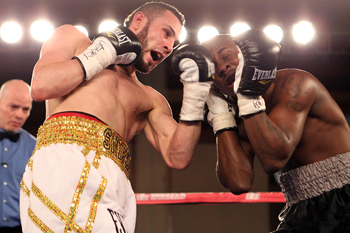 Pedraza handled the short-notice assignment well and the stats reflected that. He out-landed Farmer 177-85 overall and 152-63 in power shots, landed 40 percent of his total punches, 32 percent of his jabs and 42 percent of his power punches and held Farmer to 18 percent, 12 percent and 22 percent respectively. Against a style built to frustrate opponents, Pedraza kept his cool and took care of business. He didn’t always look pretty and he certainly didn’t look like the next coming of Miguel Cotto but he added a “W” and earned the right to move on to the next step on the ladder.
Pedraza handled the short-notice assignment well and the stats reflected that. He out-landed Farmer 177-85 overall and 152-63 in power shots, landed 40 percent of his total punches, 32 percent of his jabs and 42 percent of his power punches and held Farmer to 18 percent, 12 percent and 22 percent respectively. Against a style built to frustrate opponents, Pedraza kept his cool and took care of business. He didn’t always look pretty and he certainly didn’t look like the next coming of Miguel Cotto but he added a “W” and earned the right to move on to the next step on the ladder.
Because of the undercard fights’ brevity, the main event was essentially the walk-out bout. After sending as many files to my boss as the arena’s Internet connection would allow, I returned to my room and took care of the rest.
The excitement of working a card takes a few hours to dissipate, so it was nearly 1 a.m. before I was settled enough to turn in for the evening – or rather early morning.
Saturday, Oct. 13: Just before snapping off the lights I realized the time shown on the clock radio was 13 minutes slow, an important detail to remember since I was supposed to meet my two carpool mates in the lobby at 8 a.m. Thank the Lord for my hyper-punctuality, for otherwise I never would have thought to check that clock against my cell’s.
I arose at 6:15 a.m. – officially – and made it down to the lobby 20 minutes before my scheduled rendezvous. I spotted broadcaster/writer/future Hall of Famer Steve Farhood near the hotel entrance and we briefly chatted about the HBO doubleheader featuring Brandon Rios-Mike Alvarado and Nonito Donaire-Toshiaki Nishioka. We both thought Rios would win and that Donaire would prevail only after a difficult night.
The drive from hotel to airport went smoothly and we arrived well before our scheduled 9:54 a.m. departure time. While noodling on the laptop I spotted a couple of members from Dannie Williams’ team – adviser Sam Shapiro and trainer Jack Loew – so I stopped what I was doing to talk with them about their man’s unexpected troubles as well as show them the lopsided numbers in their charge’s favor.
Loew recalled a fight when another one of his fighters, Ken Sigurani, produced huge numbers during his 10-round unanimous decision win over Alex Quiroga on September 27, 1996. I consulted the database and found that Sigurani’s 1,050 punches, 479 total connects and 313 power connects still rated 14th, 3rdand 7thall time among welterweight fights counted by CompuBox. A few minutes later we boarded the plane destined for Pittsburgh.
Seated next to me was a fellow West Virginian who was even better traveled than I. A resident of Elkins in the southeastern part of the state, this employee in the environmental field told me about traveling to China, scaling Mount Kilimanjaro (“something I’ll never do again”) and helping to wrestle crocodiles into proper position to be tagged. The 90 minutes literally flew by and before we knew it, it was time to part ways.
The moment I stepped into the terminal I knew more work had to be done. One of my many duties with CompuBox is producing updated information on the judges working HBO-televised fights and for whatever reason I was unable to log onto Boxrec from my hotel room. When I heard the site was indeed up and running, I told them I was going to try again once I landed in Pittsburgh, which was cutting it close because by that time I had an hour to complete everything. I found a seat at one of the nearby gates, grabbed my laptop and logged in. Boxrec’s home page popped in and 50 minutes later I was finished. As soon as I got confirmation the information was received, I began the 15-minute journey toward my car. The drive home was pleasingly uneventful and shortly after 4:30 p.m. I pulled into the driveway to complete yet another adventure.
The next journey is set to begin Oct. 25 when I fly to Syracuse, then drive to the Turning Stone Casino in Verona, to work the HBO tripleheader featuring Miguel Vazquez-Martin Quintero, Thomas Dulorme-Luis Carlos Abregu and Mauricio Herrera-Karim Mayfield.
Until then, happy trails.
*
All photos by Tom Casino-SHOWTIME
Lee Groves is a boxing writer and historian based in Friendly, W.Va. He is a full member of the BWAA, from which he has won seven writing awards, including four in the last two years. He has been an elector for the International Boxing Hall of Fame since 2001 and is also a writer, researcher and punch-counter for CompuBox, Inc. He is the author of “Tales From the Vault: A Celebration of 100 Boxing Closet Classics. To order, please visit Amazon.com or e-mail the author at [email protected]to arrange for autographed copies.














